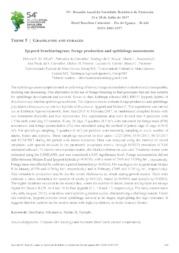Ipyporã brachiariagrass: forage production and spittlebugs assessments.
Ipyporã brachiariagrass: forage production and spittlebugs assessments.
Author(s): SILVA, D. S. M.; CARVALHO, P. de; SOUZA, R. da S.; BOURSCHEIDT, M. L.; CARVALHO, A. P. da S.; PEREIRA, D. H.; CABRAL, L. S.; PEDREIRA, B. C. e
Summary: The spittlebugs cause symptoms such as yellowing of leaves, forage accumulation reduction and consequently, stocking rate decreasing. One alternative is the use of forage breeding to find genotypes that are less suitable for spittlebugs development and survival. Focus on that, Embrapa released BRS RB331 Ipyporã, hybrid of Brachiaria spp. that has spittlebugs antibiosis. The objective was to evaluate forage production and spittlebugs population (Mahanarva sp.) in two hybrids of Brachiaria: Ipyporã and Mulato II. The experiment was carried out at Embrapa Agrossilvipastoril, from June/2016 to February/2017, in randomized complete blocks with two treatments (hybrids) and four replications. The experimental area were divided into 8 paddocks with 1.5 ha each, totalizing 12 hectares. Every 28 days, 5 quadrats (0.5 m²) were harvested for forage mass (FM) assessment, and forage accumulation (FA) was calculated using the method of paired cage (4 cage of 0.62 m²). For spittlebugs sampling, 3 quadrats (1 m²) per paddock were randomly sampling to count number of adults, foams and nymphs. These samplings occurred on four dates: 12/27/2016, 03/01/2017, 01/13/2017 and 02/24/2017 during the period with insect incidence. Data was analyzed using the method of mixed templates, with special structure in the parametric covariance matrix, through MIXED procedure of SAS statistical software. To choose the covariance matrix, the Akaike information was used. Treatment means were estimated using the LSMEANS, and was considered a 0.05 significance level. Forage accumulation did not differ between Mulato II and Ipyporã hybrids (p>0.4638), with a mean of 2960 and 3420 kg ha-1, respectively. Forage mass was affected by cultivars x period interaction (p<0.0024). FM was higher for Ipyporã than Mulato II in January (8350 and 4430 kg ha-1, respectively) and in February (7605 and 6130 kg ha-1, respectively). This variation in production may be due the severe Mahanarva sp. attack during growth season. There were cultivars x dates interaction for number of adults (p<0.0122), foams (p<0.0086) and nymphs (p<0.0263). The higher incidence occurred in the second data, where the number of adults, foams and nymphs are always higher for Mulato II (29, 46.4 and 18.8) than Ipyporã (1.1, 1.0 and 1.3, respectively). The rainy season starts very early (august, 2016), what allow some spittlebug intense cycles, characterizing a challenge season. Under this condition, Ipyporã presents lower spittlebugs survival at all stages, highlighting the high resistance. It suggests that this cultivar can be used in areas with high populations, as in the Amazon Biome.
Publication year: 2017
Types of publication: Abstract in annals or event proceedings
Keywords: Brachiaria, Mahanarva, Mulato II, Nymphs
Observation
Some of Embrapa's publications are published as ePub files. To read them, use or download one of the following free software options to your computer or mobile device. Android: Google Play Books; IOS: iBooks; Windows and Linux: Calibre.
Access other publications
Access the Agricultural Research Database (BDPA) to consult Embrapa's full library collection and records.
Visit Embrapa Bookstore to purchase books and other publications sold by Embrapa.

